Benchmarks
Because Cello is a superset of standard C, it is difficult to benchmark in an objective way. But either way I think it is fair to say that Cello is pretty fast. At best it is as fast as C, and at worst as fast as a JIT'd scripting language such as Java. For a more detailed look, all the benchmarking code is available on the Cello github repository.
As for actually optimising Cello programs - here are some broad statements about Cello's performance that are worth keeping in mind:
- Cello works well in conjunction with standard C.
Using standard C for tight loops and numerical computations is going to give you very fast performance. This is both natural and easy due to how simple the Cello/C interop is. Similarly, just using Cello as a high level wrapper for the main objects or components in your program is going to incur practically no performance penalty over standard C. It is also worth remembering that all of the benchmarked C programs are also valid Cello programs.
- Generic Functions have some fixed overhead.
Each time you call a Cello function such as new or get there is some
small overhead associated with it. The overhead associated with a Cello
function call is roughly 5-10 times that of a standard C function call - which
may sound bad but is actually pretty good if you consider
C++ virtual functions can be 2-7 times slower than standard C function calls.
The main issue, as with virtual function calls, is that Cello function calls
cannot be inlined by the compiler and so when calling Cello functions in a
tight loop this overhead can add up.
- Cello's data structures are runtime polymorphic.
Because Cello's data structures are runtime polymorphic rather than compile time polymorphic, in general they will never be as fast as C++ stl structures, data structures from a C macro library such as klib, or even some unityped language's data structures. Even so, their performance is still pretty decent.
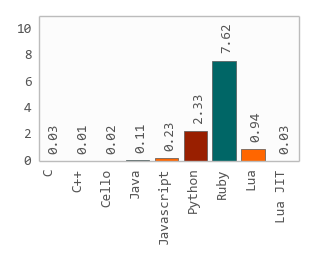
Matrix Multiplication
In this benchmark, Cello is only used here as a basic wrapper around the main objects such as the matrices. The actual multiplication is done in normal C and so is very fast. Scripting languages like Ruby and Python perform particularly badly here due to their slowness with arithmetic.

Sudoku
Similarly to the Matrix Multiplication benchmark, Cello is just used as a simple wrapper around the main objects used in the benchmarking program I.E the sudoku grid. Because all the heavy lifting is done in C the use of Cello incurs practically no overhead and performance is very similar to C.
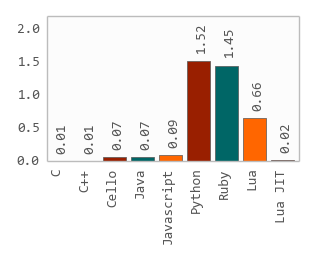
N-Body Simulation
As well as wrapping all the main objects, in this benchmark Cello techniques
are used wherever makes sense. For example foreach(b in bodies) is used
instead of for(int i = 0; i < num_bodies; i++). The intention was to write
Cello code without concern for performance. In this case because using Cello
functions blocks the compiler from unrolling loops and inlining functions it is
somewhat slower than normal C implementation but still as fast as JITed
scripting languages. This benchmark shows the overhead of using
idomatic Cello even for performance critical sections of the code.
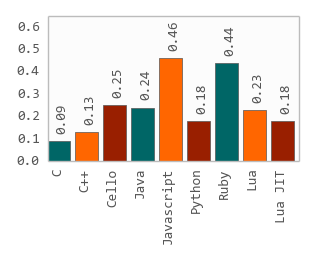
Dictionary
This benchmark shows the use of the Table structure in Cello as compared to
other language's hashtable implementations. In C the klib library is used and
in C++ std::unordered_map is used. Scripting languages tend to use optimised
C implementations of hashtables and so all of the languages perform fairly
evenly. Cello is a little slower than some of the others due to the runtime
polymorphism.

Map
This benchmark shows the use of the Map structure in Cello as compared to
other language's balanced binary tree implementations (typically red-black
trees). In C the klib library is used and in C++ std::map is used. Python
and Lua are particularly slow in this benchmark because non-C implementations
are used. Ruby uses an C implementation wrapped for Ruby objects and so is
somewhat faster. Cello achieves performance similar to Java.
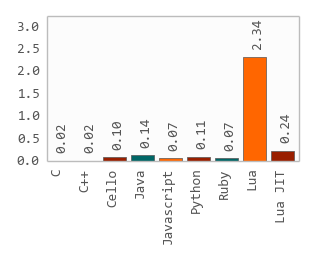
Array
This benchmark shows the use of the Array structure in Cello as compared to
other language's arrays. In C an adaption of the klib vector is used. In C++
std::vector is used. Cello's array implementation here is slower than
standard C/C++ due to being runtime polymorphic, but stays competitive with
scripting language implementations.
Lua performs very poorly because it's array type is implemented as a hash-table so many operations are much slower on it.
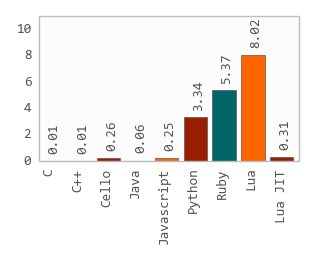
Garbage Collection
In this benchmark many objects are allocated at different stack depths. This is intended to measure a language's Garbage Collection performance. For the C/C++ benchmarks the memory is managed manually.
Cello's Garbage Collection is pretty slow compared to the incredible Java Garbage Collector, but still runs about as fast as the Javascript Garbage Collector. For interpreted scripting languages the Garbage Collection costs may be high but it is hard to tell as the whole thing may be swamped by the overhead of creating new objects. It is also worth mentioning that by manually managing memory Cello achieves performance much closer to C/C++.
